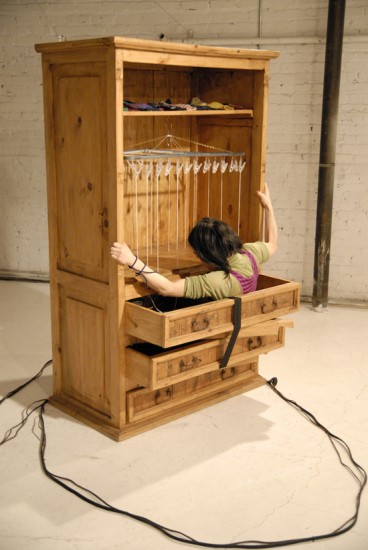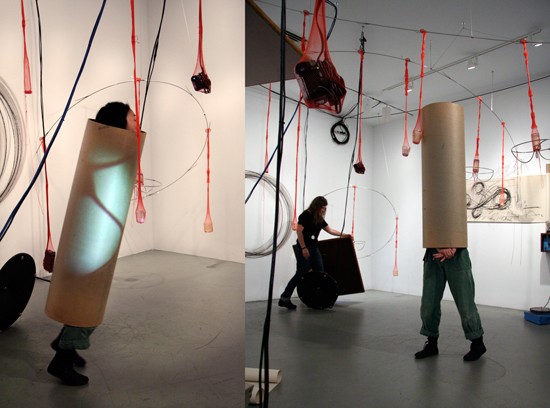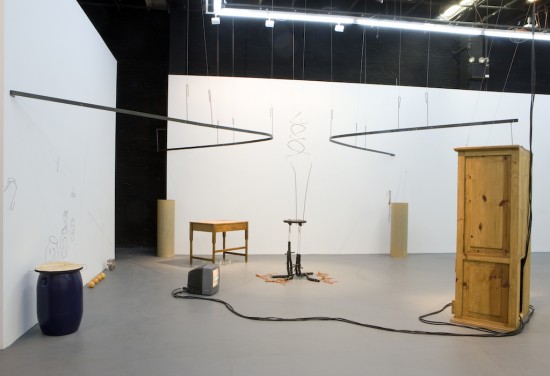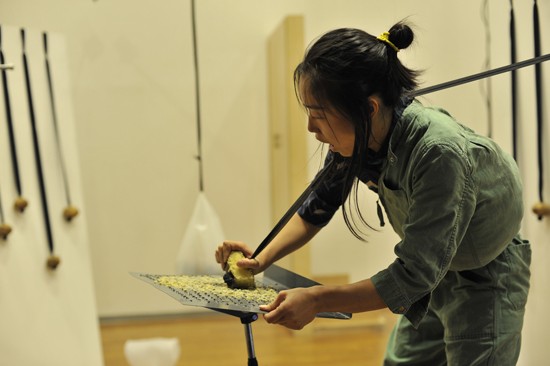Installation/Performance as Hadron
By Natsuko Odate

Performance still from the installation/performance Secrets of My Mother’s Child (2009). Photo Arturo Vidich, courtesy the artist.
Aki Sasamoto is on the move. You could say this is only natural given that she’s a performance artist, but her lips also move along with her body. What’s more, she moves about the installations she creates, installations that employ numerous moving parts. As she herself admits, her performances, which incorporate improvisation, rapid talking and strange movements repeated over and over again, are both comedic and highly neurotic, and although what she says may be logical at first, it incrementally escalates into the realm of delirium. She elicits laughter from the audience, yet she is unperturbed by the response and remains in complete control of the space around her.
Sasamoto premiered the installation/performance piece remembering/modifying/developing in 2007 at New York’s Chocolate Factory Theater and has staged it several times since, introducing minor changes on each occasion by modifying the equipment, for example. For the version presented at the 3rd Yokohama Triennale in 2008 she introduced a music stand whose top had been modified into a grater, potatoes attached to elastic cords and part of a wall that had been cut out for the purposes of “drawing” – an important element of her work – and then used these items as she moved around freely within the installation. In fact, in addition to these visible movements, the work also incorporates invisible temporal movements (what Sasamoto refers to as differences in speed), such as visuals displayed on monitors hanging from the ceiling and sounds that appear to be live but that were in fact recorded the day prior or even earlier.
Secrets of My Mother’s Child, which was staged last year at the New York art space The Kitchen following its theater premiere, is an omnibus made up of several vignettes. The work is based on actual events that took place when Sasamoto invited her mother from Japan to New York on the pretext of wanting to ask her questions that she’d always wanted to ask but had never got around to asking. Woven together in sketch form, the work comprises scenes of discommunication that resulted when her actions contradicted her strong desire for communication. Sasamoto is participating in this year’s Whitney Biennial with an installation/performance piece entitled Strange Attractors. ART iT caught up with her at the Whitney, where she is performing on select dates that include the numerals 6 and 9, reflecting an obsession inspired by maps of the Lorenz attractor, one of the “strange attractors” explained by chaos theory.

Performance still from the installation/performance Strange Attractors (2010). Courtesy the artist.
ART iT: First, could you talk about your piece at the Whitney and the creative process behind it?
AS: While I was working on the piece I was thinking almost constantly about ring-shaped objects like chikuwa fish sausages, donuts and hemorrhoid cushions. The way I create a new piece is a bit like fishing, in that for around three months after receiving an exhibition invitation I lay a net and just wait for a cluster of ideas to gather. I then pick out elements from among these ideas and assemble them together into a work. In this case I think the work reflects the things I was thinking about over the several months from summer of last year, which was when I got the Whitney invitation. It’s impossible to forcibly exclude these thoughts, so they always end up getting into the work. Also, things I’ve thought about previously but ended up not using and ideas I have used but that still leave room for further exploration sometimes end up appearing in the work.
ART iT: What is the actual relationship between your installations and your performances – what do you create first? For example, do you start by perfecting the material aspects of the installation and then think about the performance, or are they created simultaneously, with the installation coming together in the same way that we gather together in our rooms the various things we need as we go about our daily lives?
AS: Definitely the latter. I aim to put the finishing touches to both the performance and the installation during the actual exhibition. By the time the exhibition starts the installation is usually 80 percent complete and the score for the performance 50 percent complete. To use the fishing analogy that I just mentioned, the installation is more or less fixed by the time I’ve finished editing the ideas that I’ve caught in my net. That’s because the physical resistance of the objects used in the installation doesn’t allow for much adjustment.
In contrast to the installations, the performances have a relatively high degree of improvisation and flexibility, and I enjoy that disparity. Although I don’t make drastic changes to the fixed components in the installation, I sometimes do make minor changes during a performance by adding elements, or incorporating thoughts I happen to have during a performance. Or perhaps I should say they work their way in of their own accord.
On account of the resistance I mentioned earlier, installations move at a much slower speed, and the resistance exerted by the installation components changes the speed of the performance, which has its own, extemporaneous speed. In this sense, for me the installations and the performances mutually interact.
ART iT: Even when you’re not doing a performance, your works can be viewed as installations that evoke in viewers a certain awareness of absence. Should we interpret this as meaning the works are completed when you do a performance, or is this sense of absence a sign that a performance has been conducted?
AS: For me the relative importance of the installation and the performance is 1:1. Even if the meaning of each is enriched by their respective existences, I make an effort to avoid mutual dependence if this means sacrificing the completeness of the work. So I strive to avoid making decisions like using something in a performance simply because it looks cool, or leaving something in an installation because it has the aura of a performative artifact. Though I’m not sure whether being fastidious like this at the production stage translates into the finished work.
ART iT: You often incorporate video or video cameras into your installations, but how do you use them? It doesn’t appear that they’re used for recording purposes.
AS: I build the video cameras into the installations to suggest the points of view of the objects in the installations. I’m interested in how we empathize with things. I like imagining how a cup on a table, for example, views me. As for recording a performance, videographers generally focus on the performer, with the objects in the background moving from side to side as if one were looking through a train window, leaving no room for contemplation. When I’m performing, I may appear on screen for only a moment, or I may run across the screen as a background element to the objects. To allow for this possibility, during performances the camera operates in the same way that it does at other times during the exhibition.
ART iT: That relates to what you said before about the relative importance of the installation and the performance being the same, doesn’t it?
AS: I try to make it so that neither explains the other.

Performance still from the installation/performance Secrets of My Mother’s Child (2009). Photo Adam Reich, courtesy The Kitchen, New York.
ART iT: Returning to the sense of physical absence in your installation pieces, my impression is that people who see the installation only without seeing the performance can also see evidence of your presence.
AS: I create installations that are redolent of the human body. I don’t think about filmic evidence, but rather how the body comes into contact with and relates to the world, much as Le Corbusier did with his chair designs. As I said earlier, things have a certain resistance, a physical power to resist. That’s why it takes time for the sense of somebody being there to disappear. In other words, whenever I perform somewhere, or whenever I perform over and over again like with this show at the Whitney, an odor remains. However, it, too, will disappear eventually, and I don’t feel possessive about accessing these objects past that point. I prefer objects that show signs of having been used, but I’m not particular about who the person using them may have been. It can be anybody, as long as there’s some trace or odor left behind indicating that someone has used the object.
At the same time, because these objects are etched with traces particular to me and because the memories of these objects are etched into my own body, immediately after a performance I have this strong sense of identification with these things. For example, immediately after a performance the other day someone wanted a scrap of paper that I’d written on and thrown away that was obviously trash. I was conflicted about it but gave it to the person anyway, and ended up regretting it. The feeling I had was painful, as if a piece of my own flesh had been ripped away.
ART iT: Are there noticeable differences between doing a performance at a museum as opposed to somewhere else? How do external elements such as the place and the audience affect the performance?
AS: At art museums there are rules that are usually invisible that become visible as a result of my performance. I have to say I’m not that familiar with such restrictions. So I balance this by doing impromptu performances at casual places where there are no restrictions, like on the street or in restaurants. I want to protect an aspect of my naïveté. Apart from differences in rules associated with different venues, what I do in my performances is exactly the same regardless of where I perform.
Also, with regard to audiences, their existence seems essential to me. That is, I think it’s only when there’s an audience that I can perform and find the energy to do so. However, the determinants of the actual content of the performances are primarily my mood and my private life, so I’m not all that affected by considerations like the size of the audience or the setting. I am more influenced by the characteristics of the space and physical objects. What the walls are made of, the height of the ceiling, the weather, and so on. In other words, like the venues, the response of the audience doesn’t actually affect the performance. I don’t take any notice whatsoever of the audience’s response. If the audience threw cans at me I might be affected, although with this, too, I’d probably only be affected to the extent that it’s something I’m actually physically experiencing. People often come up as a topic of conversation in my performances, while my body is simply reacting to certain objects or the atmosphere.
ART iT: Why do you talk so much during your performances? You’re constantly talking as if you’re giving a lecture, but it’s not that you’re intoxicated with your talkative self; rather, you’re giving a speech.
AS: I’m interested in the discrepancies that arise from the use of speech. I’m often furious at myself for my inability to master speech, which was supposedly devised as a means of communicating one’s thoughts. I think the fact that I talk so much during my performances is due to nervousness. The more I talk the less I seem to be able to communicate, but still I can’t stop. And the more I talk the more distant I feel from the people I’m talking to. Even though I am the one who makes the audience laugh, I take a step backwards upon hearing their laughter. My lips are moving and I’m saying interesting things without thinking and with no real emotional attachment. My mouth and my feelings are detached and when I see the audience laughing I become aware of this distance.

Performance still from the installation/performance remembering/modifying/developing (2008). Photo Mineo Sakata, courtesy the Organizing Committee for the Yokohama Triennale.
ART iT: It also looks as though in a performance you’re combining different elements in a way that is logical and mathematical. Is it true of your installations, too, that the elements are carefully assembled?
AS: It’s true that I combine several moving elements. But I’m not sure whether this is logical or not. With pure improvisation, as compared to what occurs within the installation, the elements at my disposal end up reflecting all my experiences to date, so there is a degree of pre-determination involved but it also allows for drastic transformation. In the case of improvisation within an installation I’ve created, the limits are far more determined compared to improvising on the spot.
With both installations and performances, factors like the time it takes before I can use the various means at my disposal – speech, sculpture, movement and pictures – and the transmission speed once they’ve been used and the way they’re transmitted vary greatly, and I like combining them. When I’m in that threshold between the sense of despair at being unable to communicate no matter what I do and the knowledge that if I keep trying I’ll eventually get through to the audience, I move around because I want to express something regardless of what it is.
ART iT: Finally, could you tell us about the NPO you’re involved in, Culture Push?
AS: Culture Push is a both an organization that promotes connections between people and a space where I’ve completely removed my own ego. In contrast to this, my own works are an opportunity for thoroughly personal activity in which I delve deeper and deeper into myself. At present, I seem to enjoy this balancing act between external and internal activities. The future of Culture Push is something that I can’t decide on my own, so to be honest I don’t know how it will develop. It has the potential to become a good pretext to meet various people, so I hope it turns into the kind of organization that grows naturally through such encounters. In art today, I think it’s extremely important not only to concentrate on one’s own art making, but also to think about how we relate to society, how to contribute to society and how to communicate ideology. In that sense, the activities of Culture Push are really important to me.
Born in 1980 in Yokohama, Aki Sasamoto left high school and went to the UK, and later moved to the US, where she now resides. She completed her MFA at Columbia University School of the Arts, and is currently based in New York. She studied mathematics, dance and art, which she combines in her works. Moving freely across genres, she presents mainly performance works involving sculptural elements. Major group exhibitions include the 3rd Yokohama Triennale (2008), “One More Minute” (The Kitchen, New York 2009) and the 2010 Whitney Biennial.
